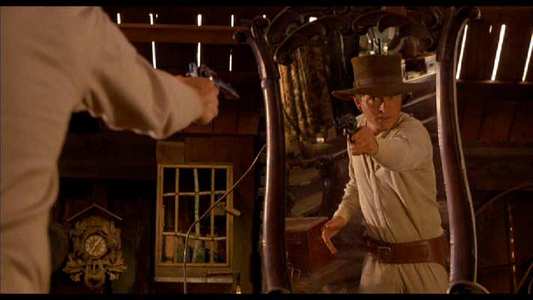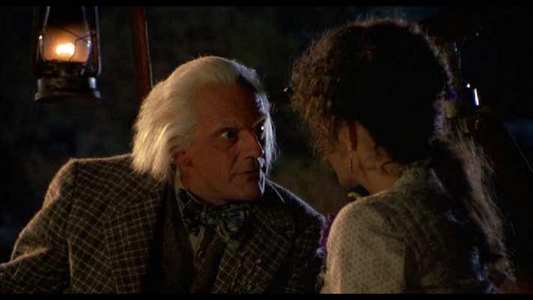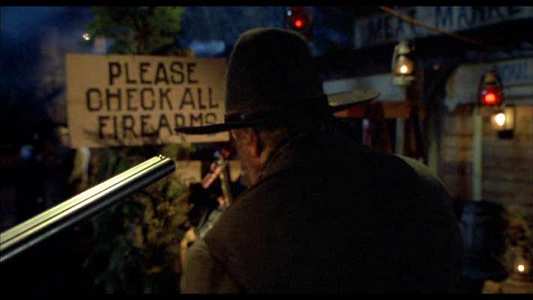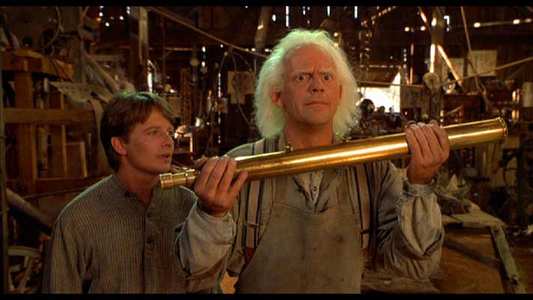Review of Back To The Future Trilogy (3 Discs)
Introduction
`Great Scott!`
A much-anticipated event, the release of the Back to the Future trilogy has created some debate about the discs, the price, the extras; you name it but what about the films themselves?
Back in 1985 when the millennium seemed a lifetime away there were plenty of films vying for the youth audience. We lapped up Ghostbusters, Gremlins, Indiana Jones, and of course, the Star Wars films. The cinema was making `big` films again and the time was right for Grease to meet the Time Machine. Unfortunately, or depending on how you view it, fortunately, some of us are old enough to remember the theatrical release of these movies particularly Back to the Future, Part the First (as it turned out).
A film made with the purest of intentions -to make money!
Back to the Future
A whole film based on Bob Gale`s dad`s yearbook -what would happen if you met your dorky Dad at High School? The method of engineering this meeting had to be a time machine and so the idea was born. They might have wished that they had stuck to the original time-travelling fridge after DeLorean went bust but at least the car`s distinctive style spawning a million movie posters has stayed fixed in our collective memory.
By a sheer accident Marty travels to the past and manages to botch his parents first meeting thus creating a future time-line where he does not exist. He has to engineer a new meeting that will enable his parents to meet, get married and produce him and his two siblings. In doing this he also invents rock and roll. (Well-done Marty!)
Back to the Future did not demand a sequel but the studio asked Bob & Bob, and they said yes. Apparently the Studio would have made one anyway so think yourselves lucky that the Two Bobs managed to get the same team to complete a trilogy.
Back to the Future II
The sequel not made until nearly five years later is a much darker film in every sense, where the materialism seen brought to life in Marty`s desire for the 4x4 creates a darkly alternative present. Although ostensibly created by Biff, the changed Hill Valley is traced back to Marty`s desire to `help himself` to a slice of luck by purchasing the sports almanac in 2015. This world is also violent, possibly too much so for a film that was really aimed at young adults. The sleazy town that Biff makes, looks very extreme, the type of alternate reality often favoured nowadays by Sci-Fi shows. Future town also looks rather peculiar given that it was only looking 25 years on-how dull we seem compared to our future dreams.
Marty has to revisit 1955 and contrive not only, not to meet his parents but also himself. Not surprisingly the clapperboard used for this film was `paradox` as the plot ties itself into one heck of a Gordian knot! Leaving all laws of time and space aside (well just throwing them out of the window) the knot unravels until all is resolved except the signposted cliff-hanger ending to get us back into our seats for the next instalment.
Back to the Future III
The third film really is an excuse for an old fashioned Western made at a time when nobody else was making them. It cheekily borrows not only Clint Eastwood`s name but also some set pieces from his `spaghetti` era.
Having traced the Doc to the past in film II by means of a Western Union letter (probably be UPS these days!) Marty resolves to rescue him from certain death at the hands of `Mad Dog Tannen`. Enlisting the help of the 1955 Doc Brown he is able to get the time machine working again and goes back to the old West dressed like a 1950`s TV cowboy (looks a bit like Woody from` Toy Story`).
This final instalment rounds off the trilogy with a with a morality tale. Marty McFly gets to grow up and develop a more mature attitude to life through the lessons learnt in the past. In the first film he gets the parents he always wanted but Marty is still the product of his original upbringing. The third film is his `coming of age` where he grows into his new family and the responsibilities of being an adult.
It is unlikely that the sequels would have been so successful if they had been `franchised` and despite their flaws they make a quite satisfying whole.
The packaging is a little flimsy with too much cardboard that will suffer in our house. Presumably putting the whole thing into a decent plastic wrap would have pushed down their profit margins.
The animated menus are nicely put together, but there does seem to have been a production problem as several people myself included have problems running the bonus features. Having tried my computer and my trusty Sony I`m a bit peeved.

Video
These films are mad before digital techniques are basically manual. They seem to have made things up as they went along necessity being as ever the mother of invention.
Some work has been done on the films but this is not a Special Edition.
Back to the Future
This film is showing its age more than the two sequels but pretty good transfer nevertheless.
It is 17 years old and technology has sure moved on since then. However looking at the film as a whole you realise that most of it does not involve any major visual effects. The time machine is used only briefly. Most of the visual effects are more concerned with stunts and makeup of the young actors, which involved a lot of work off camera.
The film itself has been issued in anamorphic Widescreen and looks fairly clean-they haven`t redone any effects like other films-no revision of the gun content or nuclear material!
Back to the Future II
This film, being slightly younger, looks brighter and clearer. The visuals that set up the future of Hill Valley are good. The use of the hover boards is pretty amazing and just incredible they were able to get hold of those prototypes…
The family shots of Michael J Fox talking to many different versions of himself had to be shot individually -these days it could all be done digitally. Again they have not revisited any of these effects and they stand up pretty well.
Back to the Future III
Made back to back with II this one again looks sharper than the first film. Mainly a Western with some special effects at the beginning and end this film relies on its stunt team more than anything else. Some beautiful visuals of Monument Valley with some very incidental Native Americans just to establish we are in the old West.
It was very important that the visual quality was good enough for DVD because this film is dependent on our impressions of Hill Valley and its continual transformations. The attention to detail has been repaid as it stands up well to repeat viewings.

Audio
Back to the Future
The films have been remastered with a DTS apparently sacrificing some extras.
The orchestral soundtrack lifts the film out of the average teen movie. It has more gravitas than the popular music soundtracks that date a movie. Having said that it has `Power of Love` by Hewie Lewis and the News and another track called `Back in Time`. The first track does help the momentum of the film as it establishes the character of Marty.
Back to the Future II
Again the soundtrack is consistently good with the music being recreated by Alan Silvestri. There is a partial repeat of `Johnny be Good`. Not as memorable as the first with no central song this time.
Back to the Future III
The addition of some good `ole boys and country music give the film its Western feel. `Doubleback` is not such a strong song as Power of Love though.
The dialogue is clear on all the films and strong scripting enhances all the films.

Features
Back to the Future
The most interesting ones on all three discs are the documentaries on the Making Of the Trilogy. These still leave some questions unanswered but making a respectable addition.
The Commentary of the Two Bobs is enjoyable but as it is based on a Q&A session the comments do not usually tie in with what you are watching on the screen. One advantage is you can just play the sound (I always like to see a silver lining), but it is not a commentary guys!
The animated anecdotes are only included on Disc One, which again is a shame because they have some excellent anorak comments.
Back to the Future II
Not a huge amount apart from the continuation of the documentary.
There is also highly secret footage of the hoverboard`s trials -I won`t spoil the surprise…
Outtakes, storyboarding, production archives and theatrical trailer.
Back to the Future III
Documentary continued
Again a lot less on this although as a special treat there is a ZZ Top Music video. Not sure why they included this when there is no video of Hewie Lewis of a surely more memorable song.
Outtakes, deleted scenes, production archives, storyboard to feature comparison, and theatrical trailer.
I had real problems accessing the bonus menu and this has been mentioned on the forum. This meant it was difficult to get the anecdotes to run and they just turned up half way through the film as the subtitles occasionally do on my machine! The anecdotes also made my machine pause just before each one came up which was a bit of a pain.

Conclusion
Back to the Future released in 1985 looks fresh and original and is far more gripping than some of the modern blockbusters that rely so heavily on special effects.
It has the power of a strong story, appropriate and thoughtful casting and attention to the sort of fine detail that to many viewers would be simply throwaway.
The second and third films could not have been made as standalone but the enticing power of the sequel is such that they demand your attention and the third film in particular rewards your persistence.
As the extras and other problems have dominated the discussions then let us consider them. Perhaps the key words missing from the wrapper are `special edition` and therein is the rub. The market is led by the desire to split the disc issues into more and more sub sets for the average viewer who will pay £x and the collector who will dig deeper to get what he perceives to be the ultimate Director`s Cut. This disc falls between two stools and you get, just about, what you pay for.
As an average viewer who has other things to do, and many more films to view before I sleep, there are just about enough but the commentary and anecdotes should have been put on the discs purely because it makes Universal look like cheapskates.
This DVD trilogy has been much heralded and is for me an opportunity to revisit films now shown usually on rather a poor copy on the television. Film Number 1 was one of the biggest films of the decade, a huge box office success and the sequels rather inevitably followed. The Two Bobs admit they would have planned it better if they had thought about sequels as they got a huge headache from getting rid of the girlfriend (couldn`t have given her something interesting to do then lads?) The second film is more problematic and the tone is not quite right for the teen audience. However, if you stay with it the ending that leaves Doc in the Old West gives a lead into a final film that recaptures much more of the joy of the original.
The complex layering of repetition for Marty in all three films is superb. He wakes up with his mother after banging his head; he crosses the road towards the Clock Tower and nearly gets run over, and continues to encounter Biff until he learns how to deal with him. The déjà vu is deliberately enhanced and is much more appealing than the more rerunning of plots in the lazy sequels of late such as MIBII.
These films really do reward continued viewing but a note of caution, on how much these sorts of films get analysed.In the Q&A session the moderator asks Bob Zemeckis whether he deliberately chose Marty as his lead character`s name because the film of `Marty` won the Oscar in 1955. `I never even thought of it…it was just a coincidence`-but surely Bob, there is no such thing as coincidence?
Your Opinions and Comments
Be the first to post a comment!